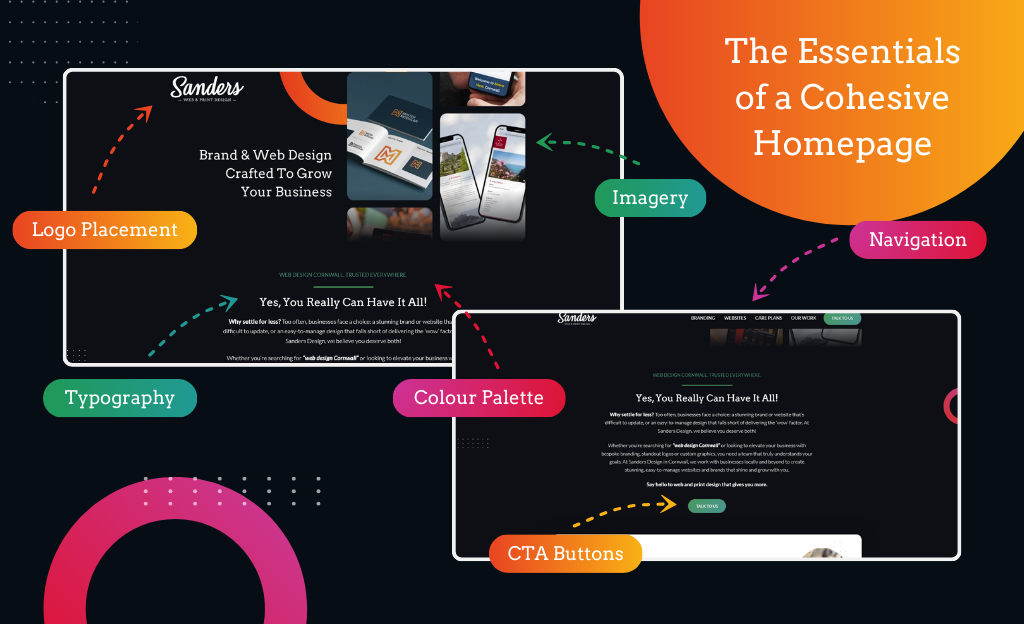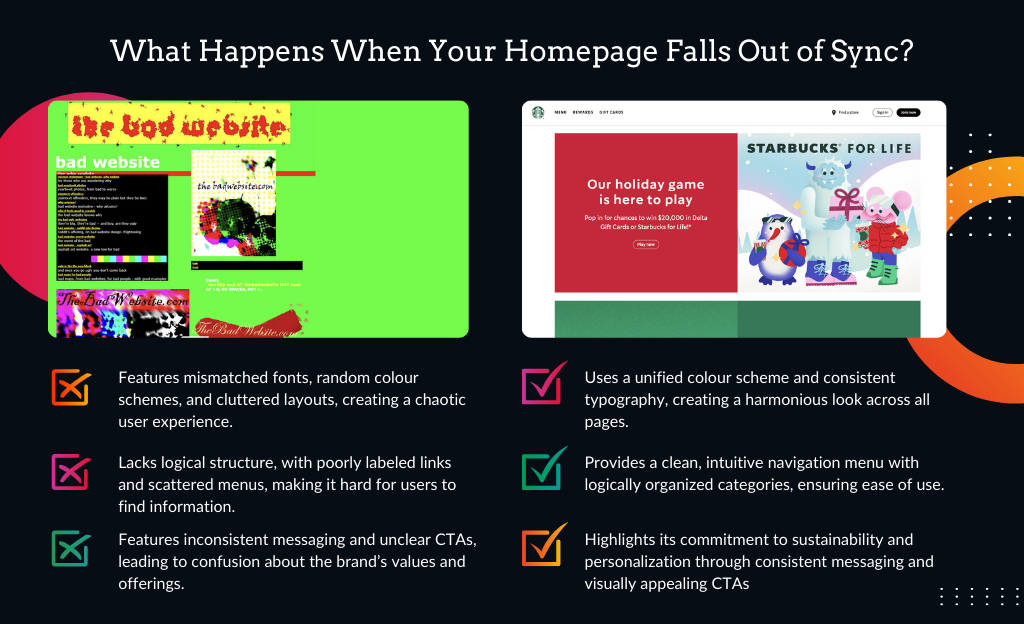Why Your Homepage Needs to Be Consistent with Your Brand

Your website’s homepage is often the first interaction potential customers have with your brand. It’s the digital storefront that sets the tone for everything else, making a lasting first impression. A homepage that reflects your brand’s values, visuals, and messaging is crucial for building trust and ensuring a seamless experience across all platforms.
In this post, we’ll explore why homepage consistency is vital for brand trust, provide tips for maintaining a cohesive design, and offer practical steps to audit and align your homepage with the rest of your branding.
How Homepage Consistency Builds Trust

Your homepage is more than just an entry point to your website. It’s a key touchpoint that reinforces your brand identity and communicates your core values to visitors. Here’s why a consistent homepage design is essential for building trust:
- Creates a Strong First Impression: Your homepage is often the first thing users see, and as the saying goes, you never get a second chance to make a first impression. A homepage that aligns with your brand’s visual identity and messaging immediately tells visitors they’re in the right place. Consistency in design, tone, and content helps create a positive initial experience, making users more likely to explore your site further.
- Reinforces Brand Recognition: Your homepage should echo the same branding as your other platforms-whether that’s your social media, email marketing, or physical materials. When visitors see the same logo, colours, fonts, and tone on your homepage as they do elsewhere, it reinforces brand recognition. This consistency helps build trust because customers know they’re engaging with the same brand they’ve seen before.
- Communicates Professionalism and Reliability: A well-designed, consistent homepage communicates that your brand is organised and professional. Inconsistent messaging, visuals, or tone can create confusion and make your brand appear unreliable or disjointed. A cohesive homepage reassures visitors that your brand is credible and trustworthy.
- Sets Expectations for the User Experience: Your homepage sets the tone for the rest of the user experience. When visitors encounter a consistent brand message and design, they know what to expect as they navigate your site. This consistency reduces friction and confusion, making it easier for users to trust the process of interacting with your brand.
Tips for Maintaining a Cohesive Homepage Design

Maintaining consistency across your homepage requires thoughtful design and attention to detail. Here are some practical tips to help you create a cohesive homepage that aligns with your brand:
1. Use Your Brand’s Colour Palette
Your brand’s colours should be clearly reflected throughout your homepage. Stick to your primary and secondary brand colours when designing buttons, headers, backgrounds, and other elements. Using a consistent colour palette reinforces your brand’s identity and creates a unified look across your website and other platforms.
2. Ensure Logo Consistency
Your logo is the visual anchor of your brand and should be prominently displayed on your homepage. Ensure it’s used consistently, with the correct size, placement, and colour. A distorted or incorrect version of your logo can undermine your brand’s professionalism.
3. Maintain Font and Typography Standards
Just like your colours, your fonts should be consistent across your homepage and in line with your brand’s typography guidelines. Use your designated brand fonts for headlines, body text, and call-to-actions (CTAs) to create a cohesive look. Avoid mixing too many fonts, as this can make your homepage feel chaotic and inconsistent.
4. Align Tone of Voice with Brand Personality
Your homepage copy should reflect your brand’s tone of voice-whether it’s professional, casual, friendly, or authoritative. The tone used in your website headlines, product descriptions, and CTAs should align with the way you communicate across other platforms. Consistent tone helps reinforce your brand’s personality and makes your messaging more relatable to your audience.
5. Use High-Quality, Brand-Aligned Imagery
The images and visuals on your homepage should support your brand’s story. Use high-quality images that reflect your brand’s values, and avoid generic or irrelevant stock photos. Whether you use product photography, lifestyle images, or custom illustrations, ensure they align with your brand’s visual style.
6. Ensure a Consistent Layout and Structure
Your homepage layout should follow a clear structure that makes navigation easy and intuitive. Maintain a consistent layout across the homepage and other pages on your site to create a seamless experience. Key elements like the navigation menu, footer, and CTA buttons should be placed consistently to avoid confusing visitors.
7. Include Clear, Brand-Driven CTAs
The CTAs on your homepage-whether it’s “Shop Now,” “Learn More,” or “Contact Us”—should be clear, actionable, and aligned with your brand’s goals. Ensure that the CTA buttons are designed using your brand’s colours and fonts to maintain visual consistency. The messaging in your CTAs should reflect your brand’s voice and values, encouraging visitors to take the next step.
Conclusion: Simple Steps to Audit and Align Your Homepage
Ensuring that your homepage aligns with your brand identity is an ongoing process. To maintain consistency, regularly audit your homepage to check for any inconsistencies in design, messaging, or functionality. Here are some simple steps to review and align your homepage:
- Review Visual Elements: Audit your homepage’s colour scheme, logo usage, fonts, and images to ensure they match your brand’s visual identity. Look for any outdated or inconsistent elements and update them to align with your current brand standards.
- Check for Messaging Consistency: Read through your homepage copy and CTAs to ensure the tone and language reflect your brand’s personality. Update any text that feels out of sync with your brand’s voice or message.
- Ensure Consistent Layout and Structure: Navigate through your homepage as a visitor would. Check that the layout is clean, user-friendly, and aligned with the rest of your website’s pages. If the homepage feels disjointed or confusing, consider reorganizing the content to improve the user experience.
- Test for Mobile and Desktop Consistency: Make sure your homepage is consistent across different devices. Your design, layout, and messaging should adapt seamlessly whether visitors are browsing on desktop, tablet, or mobile.
- Seek Feedback: Ask team members or trusted users to review your homepage and provide feedback on whether it feels consistent with your overall brand. Sometimes a fresh perspective can highlight areas that need improvement.
By following these steps, you can ensure your homepage reflects your brand’s identity and provides a cohesive experience for visitors. A consistent homepage helps build trust, improve user experience, and ultimately lead to higher engagement and conversions.
Need help aligning your homepage with your brand? Contact Sanders Design today for expert guidance on creating a cohesive website that reflects your brand and builds trust with your audience.


Author: Martin Sanders
I empower businesses to connect with their customers and boost sales. Ready to take your revenue to new heights? Get in touch with me today, and let’s make it happen!


